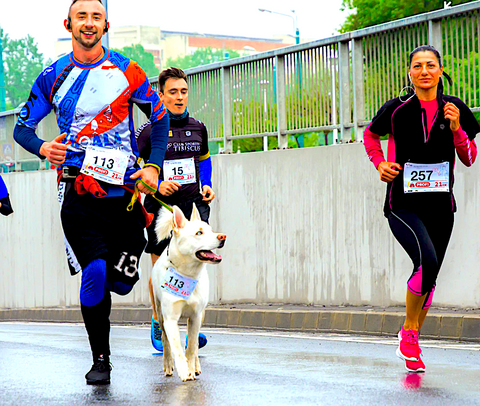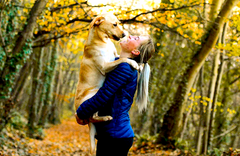
My first experience with trigger point therapy was when I was a cross country athlete in college. I was into heavy training, lack of rest, and the desire to push my body to the limits to qualify for nationals. One day, as I was running down a hill during a training run, I heard a pop and felt a burn up the back of my leg like I’d never felt before. Once I got to the bottom of the hill, I fell flat on my face with a torn hamstring.

It wasn’t completely torn but bad enough for me to be immobilized and on crutches for a month. I went back to running after a month’s time, but it never felt the same; my entire leg would seize up suddenly, almost like it was a new injury. Soon, my back started hurting and I developed headaches. My trainer performed all the known conventional therapies but nothing worked. After a year and a half of this pain, I finally found a myofascial trigger point therapist; this was the only therapy that helped me to finally recover. It was the beginning of my 25 years in the amazing field of bodywork for both humans and dogs.
What has truly amazed me in the past 25 years is the effectiveness of trigger point therapy and myofascial techniques for dogs suffering from pain and dysfunction.
WHAT IS A TRIGGER POINT?
Janet Travell and David Simons, authors of Myofascial Pain and Dysfunction: the Trigger Point Manual, describe a trigger point as simply a small contraction knot in muscle tissue. It often feels like partially cooked pieces of macaroni or like a pea buried deep in a muscle. A trigger point affects the muscle by keeping it tight and weak. At the same time, a trigger point maintains a hard contraction on the muscle fibers it’s embedded in. In turn, these taut bands of muscle fiber keep constant tension on the muscle’s attachments, often producing symptoms in adjacent joints.
The constant tension in the fibers of the trigger point itself restricts circulation in the immediate area. The resulting accumulation of the by-products of metabolism and the reduction of oxygen and nutrients can create a cycle of pain, dysfunction and constriction in the muscles, which can last for months and sometimes even years.
Trigger points in dogs are thought to have the same physiological make-up and referral patterns as in humans. Any muscle in the body can develop trigger points, though they are more common in the antigravity or postural muscles (the muscles that keep you standing up and tall).
There are two types of trigger points: active and latent. In both types, there will be a local spot of tenderness (trigger point) in a palpably tense band of muscles. Trigger points are found in the belly of the muscle and near its attachments. An active trigger point is a point of hyperirritability within the muscle or its fascia that can be felt in the muscle or can be referred to other parts of the body. The trigger point will usually refer pain when pressure is applied to it and the sensitivity of the point is usually sharp and disproportionate to the pressure applied. The referred pain pattern is specific for each muscle. The more hyperactive the trigger point, the more extensive and constant the referred pain will be.
A trigger point prevents full range of motion in the muscle and stretching it will usually be painful as tension is placed on the shortened fibers. This is why deactivating trigger points is so important: if we can release the trigger point, we can regain full range of motion. Unrestricted joint movement nourishes the joint capsule and prevents degenerative changes within the joint.
The referred pain from an active trigger point is usually deep and aching. It needs to be distinguished from the prickling pain and numbness associated with nerve entrapment or throbbing vascular pain. Sometimes referred pain can create even more dysfunction than the original trigger point.
A latent trigger point is a focus of hyperirritability in a muscle or its fascia that doesn’t cause referred pain, even when pressure is applied to it. The trigger point will be sensitive to pressure, but not as hypersensitive as an acute trigger point. Latent trigger points cause stiffness, restrict range of motion and are more common than active trigger points. A latent trigger point may persist for years after apparent recovery from an injury, only to recur and cause referred pain with muscle strain, overuse, or emotional or physical stress.
Regular massage can be instrumental in preventing the pain and dysfunction of active trigger points by identifying and releasing latent trigger points.

Myofascial trigger points are an extremely common and distressing part of everyone’s life at one time or another (think of a stiff neck or low back pain). They may be considered weak points within the muscle or its fascia and they’re particularly sensitive to stress. These weak points can contribute to muscle and fascial tearing, which can produce an inelastic scar tissue that limits the stretching or contraction of the muscle. Myofascial trigger points also cause pain and dysfunction, in addition to weakness, creating a cycle of injury.
HOW DOES TRIGGER POINT THERAPY WORK?
Trigger point therapy relaxes the muscle by breaking into the neurological and chemical feedback loop that maintains tightness or contraction. It also increases circulation that may have been restricted by the contracted tissue. Restoring circulation feeds the tissue with oxygen and rids it of excess metabolic waste. Finally, trigger point therapy directly stretches the knotted muscle fibers and the muscle’s fascia, which in turn reduces painful myofascial restriction.
WHAT DOES A TRIGGER POINT FEEL LIKE?
To the dog, trigger points are felt as tension in the muscle, pain and weakness. He may be anxious due to the pain and all of these physiological responses that he doesn’t understand. Physical pain and discomfort affect the behavior of our dogs in many ways and sometimes it’s the root cause of behavior problems.
Massage therapists will feel a trigger point as a hard knot or band of tight tissue where soft muscle should be. We may also feel an associated restriction of movement and “gluing” of the muscle fibers. When we palpate trigger points, we can see it in the dog; he’ll give what we call a jump sign that may be a twitch, a movement or a clear signal that it hurts.
Any (not necessarily all) of these symptoms may be seen when palpating a trigger point and it’s imperative to take note of any jump signs. It’s important that the therapist is skilled at reading canine body language as it can be challenging to not only find and distinguish the nature of these trigger points, but to be patient and progress at a rate that the dog will accept.
WHAT CAUSES A TRIGGER POINT IN A DOG?
Trigger points can be caused by muscle strain from sudden wrenching movements, falls, joint sprains, dislocations, or a direct blow to the muscle. Most of the time, trigger points can be successfully inactivated with specific therapy as soon as the associated injury has healed, although they may persist for years if left untreated.
A more gradual onset is also common and can be brought on by chronic stress from muscle imbalance or overuse. Anxiety, stress, structural imbalance, nutritional inadequacies, impaired sleep, excessive chewing and hypermobility of joints may also play a role.
While many trigger points are found in the belly of muscles, they can also be found on bones, connective tissue and viscera. Many dogs develop trigger points from lack of rest after soft tissue injury. This causes repeated tearing and breakdown of the tissue, resulting in weakness and an inability to heal.
Trigger points have also been found to correspond to many acupuncture/acupressure points. Although they may lie in the same points, the physiology seems to be unrelated between the two.
HOW DO WE TREAT TRIGGER POINTS?
The dog may pull away from the pressure, show an increased alertness or look back at you intensely. The dog may also whimper, growl, or vocalize in another way. The dog may move away at this point or start to lick the area or a referred area insistently. Understanding this communication is crucial because if it is ignored the massage therapist may not get permission from the dog to continue therapy. If a therapist moves too quickly or aggressively, the dog will interpret the work as a threat and may bite or never allow that therapist to touch him again. This reaction may even become generalized, causing the dog to be more nervous and adverse to handling by any human. For these reasons, it’s important to note that trigger point therapy should only be performed by a specialized trigger point therapist. If not performed properly, it can aggravate the dog’s condition or even inflict serious damage. Finesse and patience are key attributes.
Myofascial trigger points are generally treated by manual manipulation. In the veterinary community, dry needling of trigger points is becoming more and more popular. With this treatment, a dog is placed under anesthesia and acupuncture needles are placed in various trigger points of the body. This technique is much more invasive than manual trigger point therapy and can only be provided by a licensed veterinarian.
Canine massage therapists use only manual therapy to deactivate trigger points. Manual therapy has more specific effects on the trigger point than dry needling and carries much less risk to muscle attachments. Its directness also makes manual trigger point therapy massage as effective as injections and is actually safer for surrounding blood vessels and nerves where injections may be dangerous.
Trigger point therapy and associated techniques are an important part of rehabilitation. Many veterinarians now support trigger point therapy as a part of rehab programs and for pain management. Once a dog learns to accept this work and feels the relief associated with it, he’ll be soon be scheduling his own appointments and signing the checks!
Author: Denise Theobald, LMT, CVMRT, NCCMT
Need a virtual consult with a massage, myofascial, or rehab expert? Click below:




